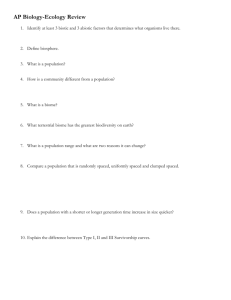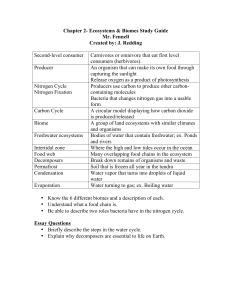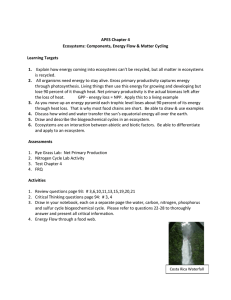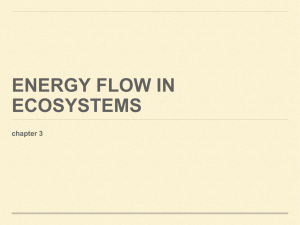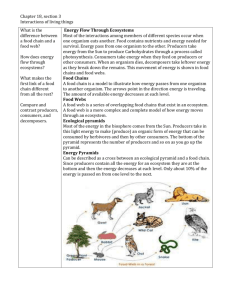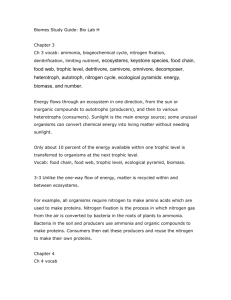Ch 36 powerpoint - Plain Local Schools
advertisement
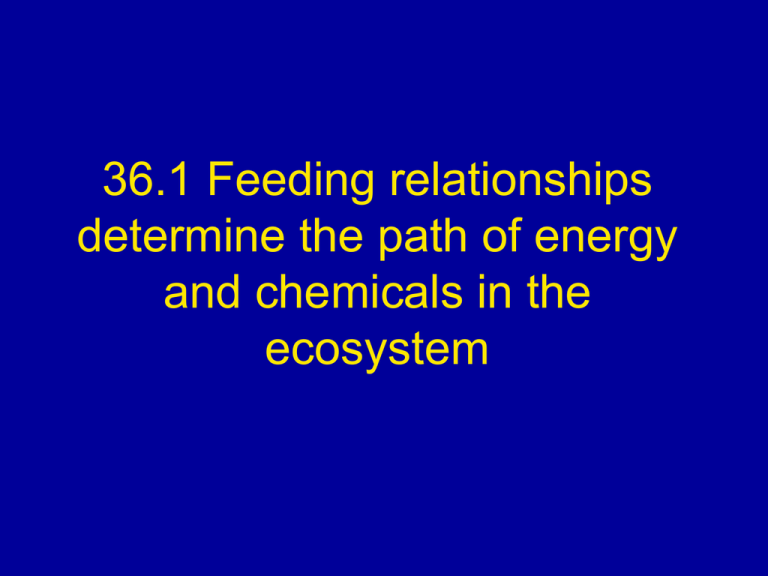
36.1 Feeding relationships determine the path of energy and chemicals in the ecosystem I. Energy Flow and Chemical Cycling A. Energy enters an ecosystem as light. B. Photosynthetic producers, like plants, change light energy to chemical energy (organic compounds). C. Consumers obtain chemical energy by feeding on producers or on other consumers. D. Decomposers break down wastes and dead organisms. E. As living things use chemical energy, they release heat/thermal energy. F. Energy is not recycled within an ecosystem, but flows through it and out. (light energy into chemical energy into heat energy) G. Chemicals, such as C, O, & N, can be recycled between living & nonliving parts of ecosystems & the biosphere II. Food Chains A. A food chain is a pathway of food transfer from one trophic level (feeding level) to another (see Figure 36-2). B. Producers make up the trophic level that supports all others. C. Consumers are the organisms in trophic levels above producers. D. Consumers can be categorized by what they eat: 1. Herbivores eat only producers. (i.e. cow eats grass) 2. Carnivores eat only other consumers. (i.e. lion eats zebra) 3. Omnivores eat both consumers and producers. (i.e. bear eats salmon & berries) E. Consumers can be categorized by position in a food chain. 1. Primary consumers feed directly on producers (i.e.grasshoppers eating plants) 2. Secondary consumers eat primary consumers. (i.e. mice eating grasshoppers); Tertiary eat secondary… F. Decomposers feed on & break down detritus (wastes & remains of dead organisms). 1. The main decomposers are bacteria and fungi; they’re abundant in soil. 2. All ecosystems include decomposers even though most food chains don’t show decomposers. III. Food Webs A. Feeding relationships are usually more complicated than shown in simple food chains. B. Ecosystems contain many different species that have a variety of food sources. C. Food webs show the feeding relationships between interconnected & branching food chains A Desert Food Web 36.2 Energy flows through ecosystems I. Productivity of Ecosystems A. Available energy or energy budget is limited in an ecosystem. B. For most ecosystems, the amount of sunlight that enters the ecosystem determines the budget. C. Earth’s producers make billions of kilograms of organic material, or biomass, each year. Productivity D. The rate at which producers build biomass is called primary productivity. E. Primary productivity determines the maximum amount of energy available to all the higher trophic levels in an ecosystem. Productivity F. Productivity is different for different ecosystems: 1. Tropical rainforests have the highest productivity. Why? Their warm moist climate supports year-round growing. 2. Productivity is low in typically dry & cold Tundra. 3. Conditions are more moderate for producers in grasslands Productivity Rain Forest Grasslands Tundra Productivity G. Exception – organisms living in deep dark ocean do not get their energy from the sun; prokaryotic producers can extract energy from sulfur compounds released by hydrothermal vents to make organic compounds. II. Ecological Pyramids A. Energy is “spent” at each step of the food web. B. As each consumer feeds, some energy is transferred from the lower trophic level to the higher trophic level. C. An average of 10% of the available energy at a trophic level is converted to biomass in the next higher trophic level. D. The rest of the energy (about 90%) is lost as heat. E. The amount of energy available to top-level consumers is tiny compared to that available to primary consumers. F. It takes a lot of vegetation to support higher trophic levels. G. Most food chains are limited to three or four levels because there is not enough energy at the top of the energy pyramid to support another trophic level. H. Ecological pyramids are diagrams used to depict information about energy, biomass, and numbers of organisms at different trophic levels. An Energy Pyramid 36.3 Chemicals cycle in ecosystems I. The Basic Pattern of Chemical Cycling A. Chemical cycles usually involve three general steps: 1. Producers incorporate chemicals from the nonliving environment into organic molecules. 2. Consumers feed on the producers and use some of the chemicals from the producers for their own life processes and release some back into the environment as waste. 3. Organisms die & decomposers break them down, supplying soil, water, & air with chemicals in inorganic form. The producers gain a renewed supply of raw materials for building organic matter & the cycles continue. B. Part of each chemical’s cycle involves nonliving processes like rain and fires. II. The Carbon and Oxygen Cycle • All living things are made up of chemicals that include carbon. Carbohydrates, fats and proteins contain carbon. • Carbon is also found in the nonliving parts of the environment. Ex: Carbon dioxide and oxygen are found in the air and in bodies of water. Carbon is found in fossil fuels, such as coal and oil. • Plants and other organisms that undergo photosynthesis take in carbon dioxide and use it to make • food. Animals take in carbon containing chemicals when they eat plants or other animals. Carbon-Oxygen Cycle • During photosynthesis, plants use carbon dioxide and release oxygen through their leaves and other plant parts. Animals use oxygen and release carbon dioxide when they exhale. • E. Decomposers break down detritus and release CO2 gas. • F. Burning fossil fuels (coal, oil, natural gas) & wood releases CO2 gas into the atmosphere. • G. Volcanic eruptions add CO2 gas to atmosphere. Carbon-Oxygen Cycle III. The Nitrogen Cycle A.Nitrogen is a gas that makes up about 78% of the air. B.Many chemicals important to living things, such as proteins and DNA, contain nitrogen. However, the nitrogen in the air is not in a form that organisms can use. C. Certain bacteria are able to change nitrogen gas into a chemical, called ammonia, that plants can use. These bacteria live in the soil and in the roots of some plants. Nitrogen Cycle D. The process by which the bacteria change nitrogen gas into ammonia is called nitrogen fixation. E.During this process, certain bacteria change the ammonia into chemicals called nitrates. Plants use both ammonia and nitrates to make proteins and other chemicals they need. F.Not all nitrates are used by plants, bacteria change some of the nitrates back into nitrogen gas, allowing the nitrogen cycle to continue. Nitrogen Cycle • G. Animals get the nitrogen they need by feeding on plants or on animals that eat plants. • H. When organisms die, decomposers change the nitrogen containing chemicals in the organisms into ammonia. The ammonia may then be used by plants or may be changed into nitrates by bacteria. Nitrogen Cycle IV. Water Cycle A.The water cycle shows how water cycles between the living and the nonliving parts of an ecosystem. B.The most noticeable water in ecosystems is the water found in lakes, rivers and oceans. In addition, groundwater exists beneath the surface of the land. C. So, what happens when a puddle of water dries up? As the puddle dries, the liquid water changes into a gas, or evaporates. D. This gaseous water is called water vapor. Water from oceans, lakes and rivers evaporates and becomes part of the air. Water vapor comes from other places, too. Water Cycle • E. Organisms produce water when they get energy from food during cellular respiration. Plants release water vapor through their leaves (transpiration). Animals release water vapor with their breath and with their wastes. • F. Water vapor is always in the air, but you cannot see it. You can see this on a glass with ice in it. Water vapor from the air condenses (changes into a liquid) on the outside of the glass. Water Cycle • G. Water vapor in the air may cool and condense into water droplets in a cloud. When enough water gathers in a cloud, rain or snow may fall. That water is used by organisms for various life processes. Ex: Plants take in water from the soil through their roots. Animals drink water from ponds or streams or get water from the food they eat. Water Cycle 36.4 Human activities can alter ecosystems I. Human Activities Impact Carbon Cycle A. Deforestation – clearing forests for agriculture, lumber, etc., affects carbon cycle by eliminating the plants that remove CO2 from atmosphere. - burning the trees would increase CO2 and accounts for about 20% of CO2 added to atmosphere by human activity. B. Burning fossil fuels increases CO2 levels & accounts for about 80% of CO2 added to atmosphere by human activity. Impact the Carbon cycle C. Adding CO2 increases greenhouse effect (a natural process) 1.CO2 & water vapor are some heat absorbing gases. 2. These greenhouse gases let sunlight through but then trap heat radiated from Earth’s surface. 3. increasing them could possibly lead to global warming (see Fig. 36-14 Impact the Carbon cycle D. Global warming is an increased average temperature worldwide E. Possible effects of global warming (even by just a few degrees): 1. melting of glaciers & polar ice caps. 2. rise in sea level & flooding low-lying coastal areas. 3. changes in weather patterns (precipitation). 4. boundaries between biomes might shift and affect species. Carbon dioxide II. Human Activities Impact Nitrogen Cycle A. Some sewage treatment plants release dissolved nitrogen compounds into streams & rivers. B. Fertilizers can run off into streams & ponds. C. High levels of nitrogen (and phosphates) in the water can cause eutrophication – rapid growth of algae (algal bloom), which later die. Bacteria decompose algae and use up so much of the oxygen that the body of water can no longer support other organisms. Eutrophication Impact Nitrogen Cycle D. Burning fossil fuels releases nitrogen and sulfur compounds into air. These compounds combine with water in the air and form nitric and sulfuric acid. Precipitation with these acids is called acid rain. 1. Compounds in the atmosphere can travel great distances. Compounds produces in the Midwest of the U.S. create acid rain problems in Eastern Canada 2. Clean Air Act has lessened problem in U.S. by reducing levels of sulfur emissions. III. Human Activities Impact Water Cycle A. Deforestation of tropical rainforests greatly reduces amount of water vapor added to atmosphere by transpiration. - this can affect precipitation patterns which affects ecosystems. B. Drawing water from rivers and underground aquifers faster than it’s replaced could cause the aquifers to run dry. IV. Other Effects of Pollution A. Biological Magnification – the process by which pollutants become more concentrated in successive trophic levels of a food web - example: PCBs from industrial wastes were detected in tissues of organisms from the Great Lakes. PCB levels increased from 0.025 parts per million (ppm) in phytoplankton to 124 ppm in herring gull eggs. - example: DDT caused shells of eagle eggs to break easily. DDT use has been banned in the U.S. and population of eagles has recovered. Effects of Pollution B. The Ozone Shield, which absorbs harmful ultraviolet radiation, has been thinning since the 1970’s. Chlorofluorocarbons (CFCs) released from aerosol cans, refrigeration units, etc., destroy ozone (O3) molecules (see Fig. 36-18) 1. Increased exposure to UV radiation can cause: - increased rates of skin cancer & cataracts. - crop yields lessened & other producers harmed. 2. CFCs have been banned in many countries. 36.5 Conservation biology can slow the loss of biodiversity I. Why Diversity Matters A. Many of the species in an ecosystem are interconnected. -Ex. if one species disappears, other species & the health of the whole ecosystem may be affected. B. People value biodiversity (variety of life on Earth) because: 1. organisms & ecosystems are sources of beauty & inspiration. 2. organisms are sources of oxygen, food, clothing, & shelter. 3. 25% of all medicines contain substances that come from plants. C. It’s important to conserve biodiversity for future uses & needs. II. Threats to Biodiversity A. Throughout Earth’s history species have become extinct – the last member of the population died and the species no longer exists on Earth. B. Periods of mass extinction occurred as a result of dramatic climate changes from volcanic eruptions & asteroid impacts. (ex.Dinosaur extinction at end of Cretaceous period). Threats to diversity C. Currently a mass extinction is taking place on Earth. It’s scale is uncertain because the 1.5 million known species are only a fraction of the total on Earth. There are signs that species are disappearing at a dramatic rate (page 806). Threats to diversity D. What threatens biodiversity? 1. Pollution 2. Habitat Destruction – as human population grows, more land is cleared for agriculture, roads, and communities. 3. Introduced (non-native) Species often prey on native species & compete with them for resources. 4. Overexploitation – the practice of harvesting or hunting to such a degree that the small number of remaining individuals may not be able to sustain a population. III. Conservation Biology A. Focusing on Biodiversity Hot Spots, small geographic areas with high concentrations of species (see Fig. 36-23) 1. Many tend to be hot spots for extinction. 2. Global efforts are being taken to preserve some hot spot areas. B. Understanding an Organism’s Habitat – to manage existing habitat or to create a new one for a species Conservation biology C. Balancing Demands for Resources – efforts to save species often conflict with the economic & social needs of people. D. Planning for a Sustainable Future 1. Nations establish zoned reserves – areas of land that are relatively undisturbed by humans, surrounded by buffer zones which are minimally impacted by humans. 2. Sustainable development – developing natural resources so that they can renew themselves & be available for the future. (ex. Selectively harvesting timber)


